The Buyer’s Journey: Everything You Need to Know
Casey O'Connor
In today’s increasingly buyer-driven sales landscape, a seller’s knowledge of their buyer’s journey is more important than ever.
Sales reps need to have an intimate understanding of how buyers make purchasing decisions in order to organically guide them through the process.
The buyer’s journey is a framework that represents the path a buyer takes in researching, understanding and naming their problem, and identifying the product that will provide their solution.
In this article, we’ll go over the ins and outs of the buyer’s journey, including why it’s so important to understand and how to align your marketing campaigns with the three main stages.
Here’s what we’ll cover:
- What Is the Buyer’s Journey?
- What Are the Buyer’s Journey Stages?
- Why Is It Important to Understand the Buyer’s Journey?
- How to Align Your Inbound Marketing Strategy With the Buyer’s Journey
What Is the Buyer’s Journey?
The buyer’s journey is a framework that outlines how buyers arrive at a purchasing decision.
The framework is broken down into stages. It starts from the moment a buyer starts to realize they have a problem that needs fixing and ends after they’ve decided on a vendor and made their purchase.
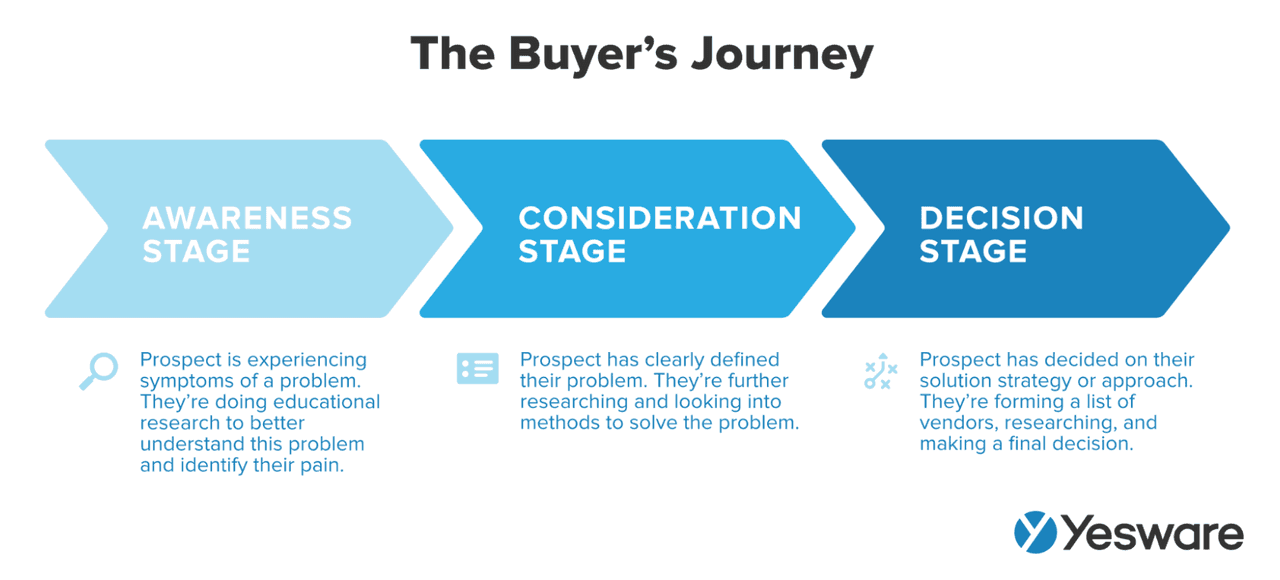
The framework allows sellers and marketers to leverage the knowledge of how a buyer makes decisions in order to best align it with their outreach and nurture strategies.
What Are the Buyer’s Journey Stages?
Although specific customer needs and behaviors vary slightly from business to business, the buyer’s journey is almost always broken down into three main stages: awareness, consideration, and evaluation.
Some sales and marketing professionals advocate for a longer buyer’s journey — one that captures the way a company continues to provide value to the client after they sign on. As seen below:
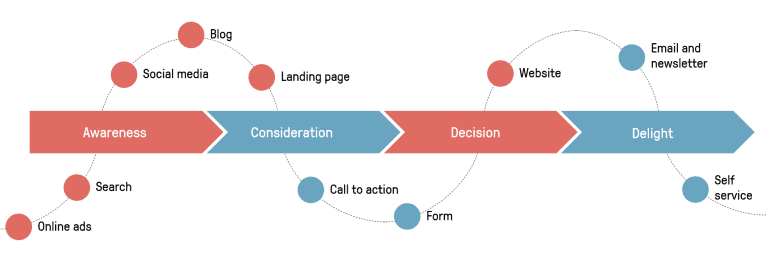
For the purposes of this article, we’ll stick with the three primary, well-known stages. That being said, it’s essential that sales, marketing, and customer success teams aspire to provide ongoing outstanding service to their existing clients; do not neglect the “Delight” stage just because it’s not commonly shown in the diagram.
The better your marketing and sales teams understand the delineations between the three stages of the buyer’s journey, the better they can curate content that will guide each potential customer through the funnel authentically and efficiently.
Awareness Stage
When buyers are in the awareness stage, they are likely only just discovering that they have a problem. They pursue further information about the symptoms they’re experiencing and seek to give their problem a name. Buyers in this stage are least likely to purchase in the immediate future.
Sales and marketing content for buyers in this stage should be informational and focused on answering questions or clearing up any confusion. Content might also be entertaining or inspiring. Whatever you do, though, avoid pushing your brand too heavily toward these buyers; over-zealous pitch attempts will turn them off.
During this stage, the goals of marketing and sales should be to generate and segment new website visitors and establish a brand reputation of advisory and expertise.
Sales and marketing teams can track how engaged leads are during this stage through metrics like the number of new visitors and total pixelated audience. They can also use data from this stage to create retargeting lists for further nurturing.
Awareness Stage Example
Let’s look at this more carefully with an example:
A B2C customer wakes up and notices that their jaw is popping when they yawn for the third time that week. It’s an irritating problem, and one that the customer feels ready to tackle. In the awareness stage, they might search for a generic, symptom-based keyword like “Jaw pops when I wake up.” They are not yet looking for a solution; they are learning more about their problem so that they can consider the appropriate solutions.
Consideration Stage
In the consideration stage, buyers have identified their problem and are now researching ways to solve it. They are still not quite ready to buy, though. They are evaluating potential solutions, and they need further guidance in determining the best way to solve the problem.
The content available for buyers in this stage should still be informational in nature, but you may start branching out to more technical or comparative analysis. Just make sure it’s authentic and not too pushy — the focus should be on the ROI of choosing something like your product, not necessarily your brand itself.
The goals of this stage are to continue nurturing relationships, gather email addresses, and build a steady following on social media. Sales and marketing can track returning visitors, banner CTA click-through rates, and visitor recency.
Consideration Stage Example
Let’s go back to our jaw-popper example:
This person now knows that they have dysfunction of the joints in the jaw. In the awareness stage, they learned that TMJ could be caused by various things — chewing too much gum or trauma, for example. They know that neither of those causes applies to them; during the consideration stage, they might pursue options related to nighttime grinding of the teeth. They might Google, “How to stop grinding teeth at night,” which brings back a blog post from a mouthguard company detailing the pros and cons of a mouthguard versus Botox versus physical therapy.
Decision Stage
In the decision stage, buyers have identified their preferred solution and are now evaluating the final contenders for specific products to solve their problem.
Sales reps and marketers can steer prospects toward choosing their product with content like case studies, demos, and testimonials.
The goals here are to maximize funnel conversion by converting leads to customers.
Decision Stage Example
At this stage, our example buyer might Google, “Best mouth guards for mild TMJ.” They are now ready to start actively comparing and selecting brands from whom they plan to purchase.
Why Is It Important to Understand the Buyer’s Journey?
On its face, the buyer’s journey framework seems surprisingly simple and straightforward. It’s also a huge buzzword in sales; it’s easy to write this concept off as “Sales 101” without giving it too much deep thought.
But sellers need to consider the buyer’s journey in the context of how the average buyer makes purchases today:
- 72% of buyers use Google to do their research on pain points and products
- 67% of a buyer’s decision is determined through independent research, long before they ever reach out to sales
- 99% of buyers report that they would be happy to buy products through a more self-service model and would be comfortable doing so with a budget of up to $50,000
Sellers can use what they know about the buyer’s journey to align their pipeline accordingly.
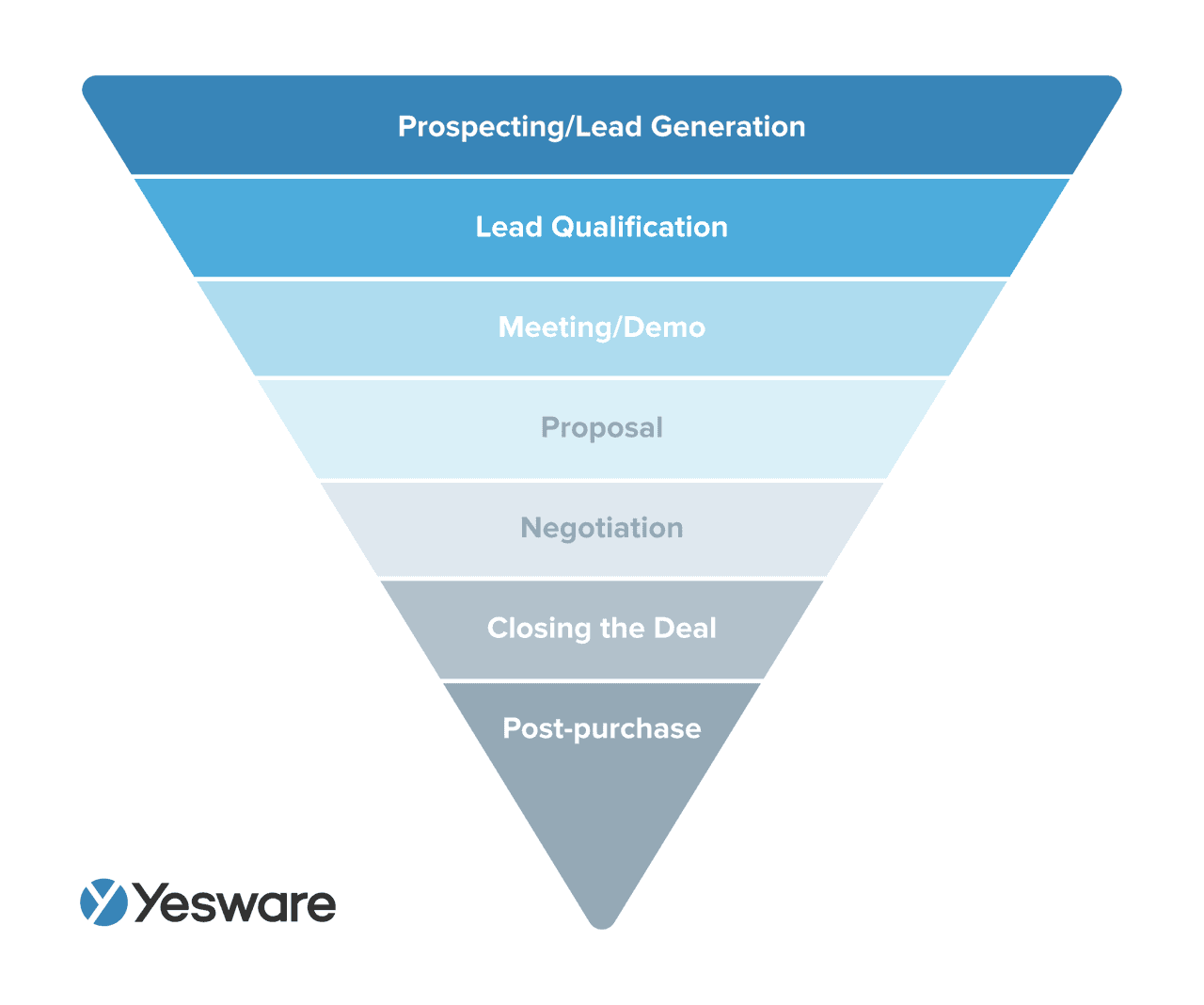
In other words, the buyer’s journey framework enables marketers and salespeople to leverage what they know about their personas’ buying habits and subsequently meet them where they are with the appropriate content to foster the buying process.
Customized Content
The more you know about how a prospect behaves throughout their path to purchase, the better you can tee up content that answers the exact questions they have.
The buyer’s journey helps sellers create digital marketing strategies intended to guide prospects according to their own needs and timeline rather than force their hands.
Lead Qualification
A funnel designed alongside the buyer’s journey will make the process of lead qualification fast and easy.
Marketers and sellers can gauge how ready a prospect may be by analyzing how they interact with your content marketing along the buyer’s journey. Tailored content can also expedite the process of churning poor fits.
Mindset Shift
With buyers taking the lion’s share of product research nowadays, it’s imperative that salespeople not become pushy with over-the-top pitches. Instead, salespeople should adopt the mindset of a trusted advisor or industry expert.
The buyer’s journey allows salespeople to shift their mindset from one of selling to one of helping by providing them a framework for the kinds of questions customers will ask when looking for a solution to their problem.
How to Align Your Inbound Marketing Strategy With the Buyer’s Journey
The following steps will help you use the buyer’s journey framework to enhance your marketing strategies.
1. Define Your Buyer Persona
In order to fully understand the path your buyer takes to purchase, you first need to understand the buyer themself.
Developing an ideal customer profile (ICP) and buyer personas will help refine your understanding of how your buyers behave and what they’re likely to need throughout the process.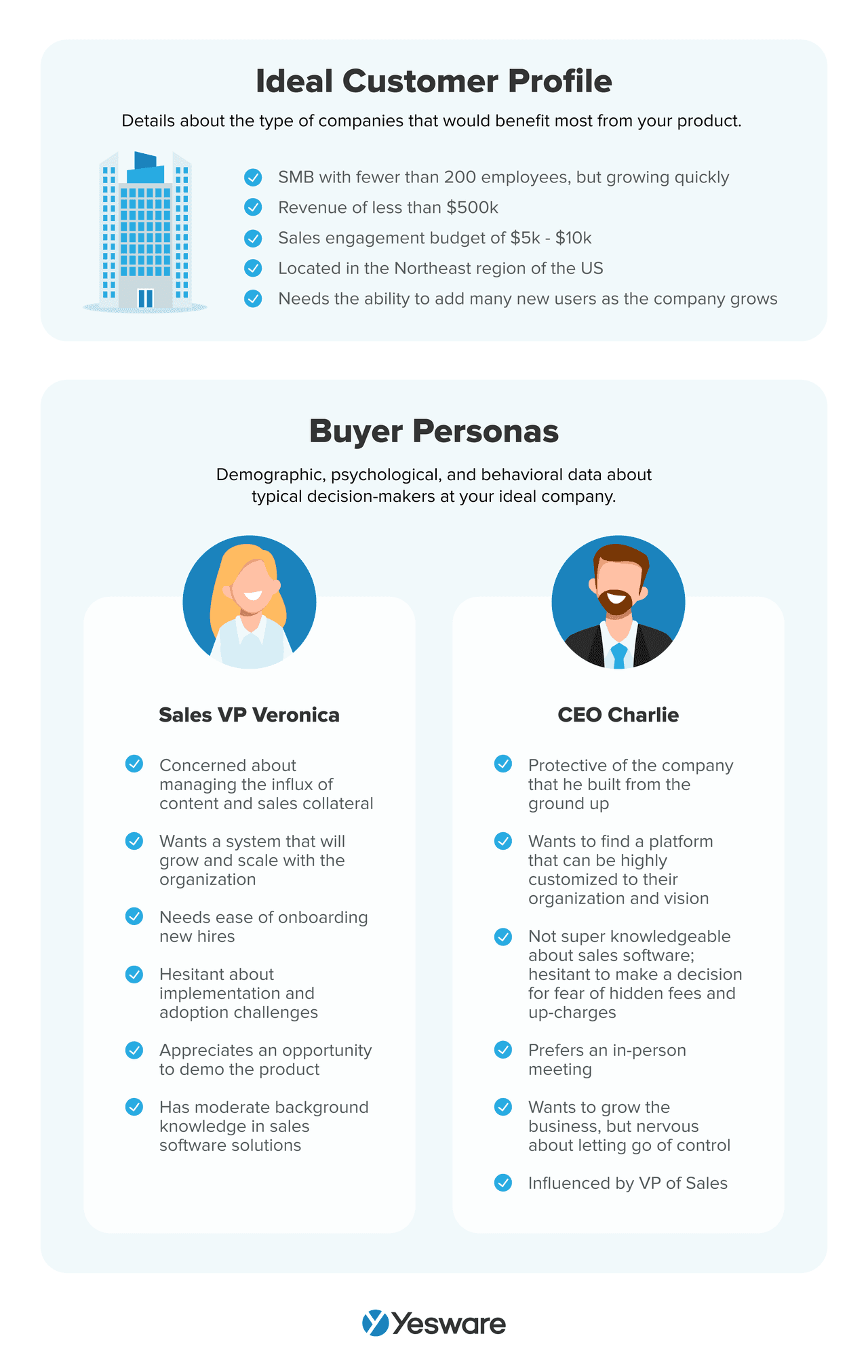
2. Understand the Journey Your Buyers Take
Once you’ve mapped your various buyer personas, you can use current customer data to help you understand how your most successful customers came to be.
Where did they start within the funnel? How did they find your brand? What content or marketing efforts resonated with them most, which helped convert them to the subsequent stages? You can reverse engineer your best accounts to figure out how they ultimately landed on your brand.
3. Map Content to the Buyer’s Journey
When you’ve nailed down the exact content and persuasions your buyers need at the various stages of the buyer’s journey, you can create content that’s specifically designed to fill those gaps.
You can then structure your funnel with readily available content and linked to specific keywords. The more automation you can bring to this process, the better.
Following this process will allow sellers the ability to nurture all good-fit leads toward conversion. A whopping 96% aren’t ready to buy when they first encounter your brand, so having the right content at the right time is imperative.
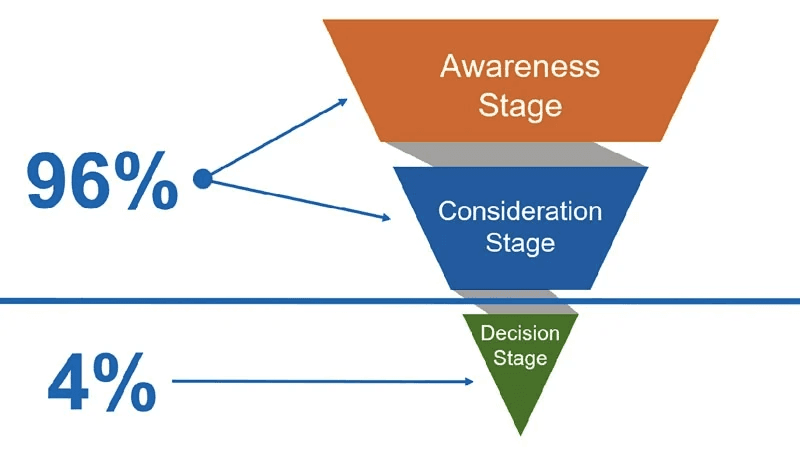
The following are some rules of thumb to consider when it comes to designing content for your buyer’s journey. Of course, there are exceptions to these depending on specific company goals and operations; always ensure that sales and marketing strategy and execution are aligned to hit your targets most efficiently.
Awareness
Potential buyers in the awareness stage are at the top of the funnel. The goal of content in the awareness stages is to encourage buyers to view your brand as a trusted source of information.
Blog posts are a great way to deliver vendor-neutral educational content. Many companies rely on them, and for a good reason — Research shows companies that blog generate 55% more traffic than companies that don’t.
You might also consider informational content like how-to videos and infographics.
Consideration
In the consideration stage, marketers will want to offer highly valuable content. In fact, the content should be so high-quality that you could consider charging for it.
Avoid the temptation of keeping your best content behind lock-and-key, and instead, think about how to make the transaction work for both parties. You could, for example, offer up a well-researched ebook in exchange for a prospect’s email address. Guides, tip sheets, and templates are also great content resources for buyers in the consideration stage.
Decision
When buyers reach the decision stage, they are looking for a reason to say yes. Give them the assurances they need through data-backed content like white papers and reports or social proof in the forms of testimonials and case studies. Webinars are another powerful tool in pushing buyers over those last hurdles.
In the decision stage, it’s okay for content to be more on the persuasive side — but, as always, it should also be authentic and honest.
Here’s a more comprehensive list of the different types of content your team might use throughout the buyer’s journey:

Has your team mapped your buyer’s journey yet? What benefits have you reaped from the process?
If you haven’t, start by outlining your buyer persona and use that to begin forming your buyer’s journey framework.
Get sales tips and strategies delivered straight to your inbox.
Yesware will help you generate more sales right from your inbox. Try our Outlook add-on or Gmail Chrome extension for free, forever!
Related Articles
Melissa Williams
Anya Vitko
Casey O'Connor
Sales, deal management, and communication tips for your inbox

